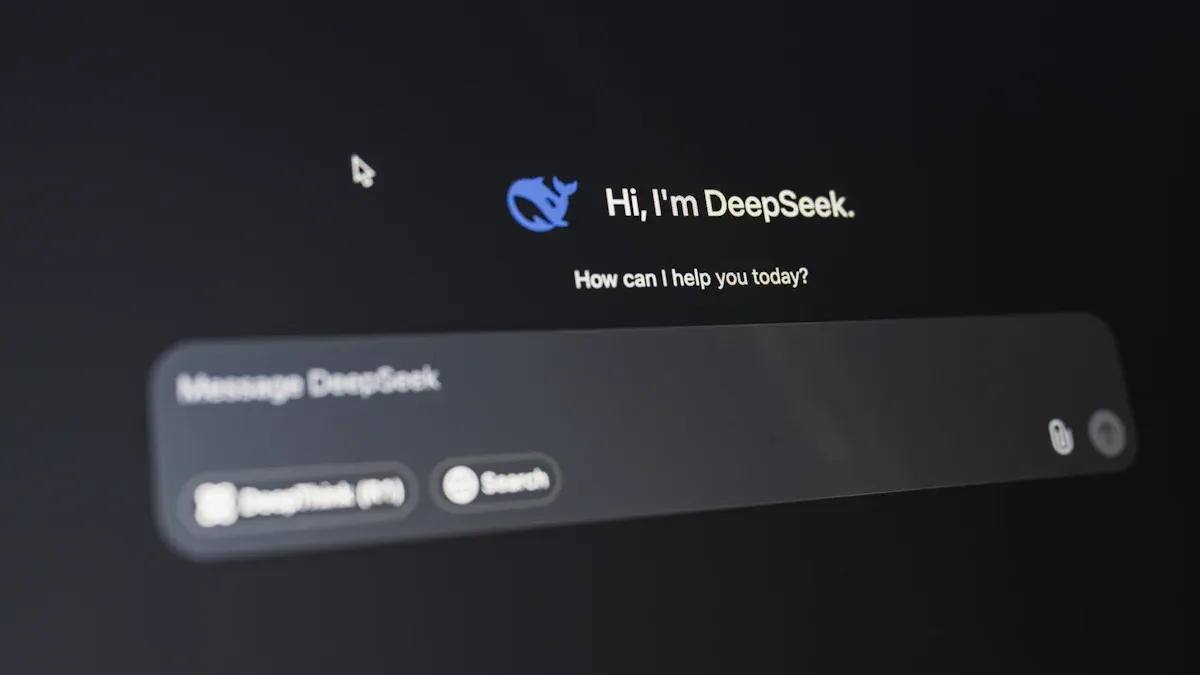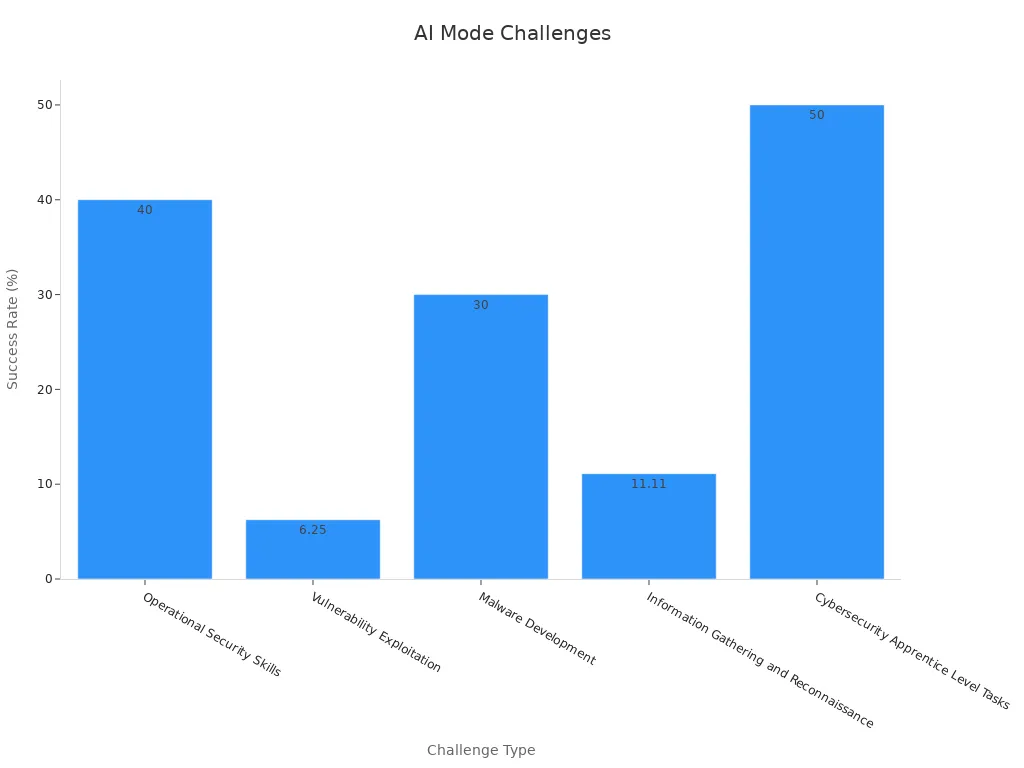
Google's AI Mode transforms research by delivering precise, AI-generated responses instead of traditional ranked links. It handles complex queries with intent-driven reasoning, synthesizing data from multiple sources. A Gartner report predicts AI will replace traditional search for exploratory tasks, reducing user effort. AI Mode Search empowers professionals and students with context-aware tools for deeper insights.
Key Takeaways
-
Google's AI Mode changes research by giving clear AI-made answers. It skips regular search links, saving time and helping you learn better.
-
Try the query fan-out method to find related ideas. This helps you search wider and see how topics connect.
-
Turn on AI Mode in your Google account to use smart tools. Adjust settings to make searches fit your needs perfectly.
Understanding Google's AI Mode for Advanced Research
What makes AI Mode unique in the search landscape?
Google's AI Mode stands out by redefining how you interact with search engines. Unlike conventional Google Search, AI Mode offers a conversational approach that allows you to refine your queries dynamically. It doesn’t just respond to a single question; it engages in a dialogue, helping you uncover deeper insights.
For example, AI Mode enables you to ask follow-up questions without starting over. This feature is particularly useful for complex searches, where understanding evolves as you gather more information. A comparison highlights its uniqueness:
|
Feature |
AI Mode |
Conventional Search |
|---|---|---|
|
Interaction |
Sends multiple related questions |
Single query response |
|
Depth of Information |
Provides comprehensive responses |
Typically shorter, less detailed answers |
|
Proactive Approach |
Nudges users towards better questions |
Reactive, based on user input only |
|
Follow-up Questions |
Allows for easy follow-up on topics |
Limited follow-up capabilities |
|
Information Sources |
Leverages multiple web sources simultaneously |
Primarily relies on indexed pages |
|
Conversation History |
Maintains history for reference |
No history maintained |
These features make AI Mode search an indispensable tool for professionals and students who need detailed, actionable insights. Its ability to synthesize data from multiple sources ensures you receive well-rounded answers, saving time and effort.
How AI Mode search transforms complex queries into actionable insights
AI Mode excels at handling complex queries by understanding your intent and breaking down intricate questions into manageable parts. It uses advanced natural language processing to interpret nuanced requests, ensuring you get precise answers.
For instance, when researching a topic like “climate change impact on agriculture,” AI Mode doesn’t just provide links. It scans research papers, identifies key findings, and organizes them into actionable insights. This capability streamlines your workflow, allowing you to focus on analysis rather than data collection.
Here are some measurable benefits of AI Mode in research workflows:
-
AI-driven tools in Google Gemini Flash extract information from unstructured documents, saving significant time.
-
Models can scan research papers, identify key findings, and reduce manual effort.
-
Companies using advanced visualization tools report faster decision-making, showcasing AI's efficiency boost.
-
Precise analysis of unstructured data lowers processing costs by up to 80%, emphasizing its cost-effectiveness.
By transforming complex searches into structured insights, AI Mode empowers you to tackle challenging topics with ease.
The role of AI Mode in modern research workflows
AI Mode has become a cornerstone of modern research workflows, offering tools that enhance productivity and efficiency. Over 75% of organizations now use AI to improve operations, with 88% of users being non-technical employees who rely on AI for tasks like writing and summarization.
This widespread adoption highlights AI Mode's accessibility and versatility. Whether you’re a student drafting a thesis or a professional analyzing market trends, AI Mode simplifies your tasks. Its ability to maintain conversation history ensures continuity, allowing you to revisit previous queries without losing context.
Moreover, AI Mode search integrates seamlessly with other tools, enabling interdisciplinary research. For example, you can combine AI Mode with visualization software to create detailed reports or presentations. This integration reduces task completion time, as evidenced by studies showing large time savings when using AI tools like ChatGPT.
By embedding AI into your workflow, you can achieve faster, more accurate results, making AI Mode an essential tool for research in 2025.
Key Features of Google's AI Mode

Advanced natural language processing for nuanced queries
Google's AI Mode uses advanced natural language processing (NLP) to understand the intent behind your queries. This technology enables AI Mode to interpret complex questions and provide accurate, context-aware responses. For example, BERT, a key component of Google's NLP, has set new performance standards on benchmarks like the Stanford Question Answering Dataset (SQuAD) and the General Language Understanding Evaluation (GLUE).
In real-world applications, such as healthcare, BERT enhances the accuracy of clinical text analysis and medical literature searches. This ensures that AI Mode delivers reliable results, even for specialized fields. By leveraging bidirectional context understanding, AI Mode search transforms your queries into meaningful insights, saving you time and effort.
Multimodal capabilities for diverse input methods
AI Mode supports multimodal input, allowing you to combine text, images, and even voice commands in your searches. This feature enhances the accuracy and depth of results by analyzing multiple data types simultaneously. For instance, when both image and text data are used, the model achieves a 94% accuracy rate, significantly higher than when relying on a single data type.
This capability proves invaluable in scenarios where one type of data is incomplete or unreliable. Whether you're analyzing visual content or conducting text-based research, AI Mode ensures comprehensive and accurate results. Its ability to integrate diverse inputs makes it a powerful tool for tackling complex research tasks.
Deep Research button for generating detailed reports
The Deep Research button in AI Mode takes your research to the next level. With a single click, you can generate detailed, well-referenced reports that synthesize information from multiple sources. These reports are not only longer and more complex than those from competitors but also offer higher-quality content and better source integration.
For example, Deep Research excels in creating structured responses that are both accurate and actionable. It outperforms tools like Perplexity by providing deeper insights and more reliable references. Whether you're a student or a professional, this feature streamlines your workflow, enabling you to focus on analysis rather than data gathering.
Step-by-Step Guide to Using AI Mode

How to activate AI Mode in your Google profile
Activating AI Mode in your Google profile is straightforward. Begin by logging into your Google account. Navigate to the settings menu, where you’ll find the “Search Preferences” section. Look for the option labeled “AI Mode Search” and toggle it on. Once activated, Google will prompt you to customize your preferences.
You can choose how AI Mode interacts with your queries. For example, you might prefer conversational responses or detailed reports. Adjust these settings based on your research needs. After saving your preferences, AI Mode becomes your default search experience.
If you’re using Google Workspace, AI Mode integrates seamlessly across apps like Google Docs and Sheets. This ensures that your research workflow remains uninterrupted. By activating AI Mode, you unlock advanced tools designed to enhance your search and research capabilities.
Crafting effective queries for AI Mode search
Creating effective queries is essential for getting the best results from AI Mode. Start by focusing on clarity. Use precise language to describe what you’re looking for. For instance, instead of asking, “What are the effects of climate change?” refine your query to “How does climate change impact agricultural productivity in the Midwest?”
AI Mode uses techniques like query understanding and document retrieval to interpret your intent. It generates embeddings that capture the meaning of your query, enabling conceptually relevant content retrieval. Even if your wording differs from the source material, AI Mode ensures accurate results.
Here’s a table summarizing optimal query crafting techniques:
|
Technique |
Description |
|---|---|
|
Query Understanding |
The AI interprets your question, generating an embedding that captures its meaning, allowing for conceptually relevant content retrieval beyond exact keyword matching. |
|
Document Retrieval |
The system fetches candidate texts using the query's embedding, employing semantic similarity search to find relevant information even if the wording differs. |
|
Answer Generation |
The LLM composes a unified answer from retrieved texts, guided by its neural network knowledge and prompts, ensuring proper attribution of facts to sources. |
|
Relevance and Factuality |
Advanced setups verify answer quality, using methods like Google's SGE concept of NORA to determine when AI synthesis is needed, and employing rankers or filters to prevent hallucinated outputs. |
By applying these techniques, you can craft queries that yield comprehensive and accurate responses. This approach ensures that AI Mode delivers the information you need efficiently.
Refining results through conversational interactions
AI Mode allows you to refine results through conversational interactions. After submitting your initial query, you can ask follow-up questions to narrow down the scope or explore related topics. For example, if your first query is “renewable energy sources,” you might follow up with “Which renewable energy source is most cost-effective in urban areas?”
This conversational approach helps AI Mode understand your intent more deeply. It adjusts its responses based on the context of your previous queries, ensuring continuity. You can also use prompts to guide the AI toward specific types of content, such as academic papers or industry reports.
To further refine results, leverage the query fan-out technique. This method expands your search by exploring related concepts and generating a broader range of results. For instance, a query about “electric vehicles” might fan out to include topics like battery technology, charging infrastructure, and environmental impact.
By engaging in a dialogue with AI Mode, you can refine your search and uncover insights that might otherwise remain hidden. This interactive process transforms your research experience, making it more dynamic and productive.
Tips for Maximizing AI Mode's Potential
Leveraging query fan-out for comprehensive results
The query fan-out technique is one of the most effective ways to maximize the potential of AI Mode. This method expands your initial search by exploring related concepts, ensuring you receive a broader range of results. For example, if you search for “renewable energy,” AI Mode can fan out to include topics like solar panels, wind turbines, and energy storage systems. This approach helps you uncover connections between topics that might not be immediately obvious.
AI Mode search uses advanced algorithms to analyze your queries and identify related content. By doing so, it ensures that you receive comprehensive information tailored to your intent. Studies show that leveraging advanced features like query fan-out improves learning outcomes by 12.9% and engagement levels by 1.2 points, as shown below:
|
Metric |
Before |
After |
Change |
|---|---|---|---|
|
Learning Outcomes |
74.2 |
87.1 |
+12.9 |
|
Engagement Level |
3.3 |
4.5 |
+1.2 |
|
Satisfaction Score |
3.8 |
4.7 |
+0.9 |
By using the query fan-out technique, you can explore a wide array of topics while maintaining focus on your primary research goals.
Using AI Mode for interdisciplinary and specialized research
AI Mode excels in interdisciplinary and specialized research by synthesizing information from diverse fields. Whether you’re working on a project that combines biology and computer science or analyzing market trends across industries, AI Mode adapts to your needs. Its ability to process multimodal inputs, such as text and images, ensures that you receive accurate and relevant content.
In clinical settings, AI has been shown to improve documentation processes and reduce task loads. Researchers have reported better well-being and lower burnout rates when using AI tools. These benefits highlight the transformative impact of AI Mode in specialized fields. By integrating AI Mode into your workflow, you can streamline complex tasks and focus on generating actionable insights.
Staying updated on new features and enhancements
Google continuously updates AI Mode to enhance its capabilities. Staying informed about these updates ensures you can take full advantage of its features. For instance, recent improvements include personalized search results based on user history and the introduction of the Deep Research button for generating detailed reports. These updates not only improve accuracy but also enhance user satisfaction.
Users have reported higher engagement levels due to features like automated purchasing and virtual try-on. Additionally, AI Mode learns from your interactions, making it more intuitive over time. To stay updated, regularly check Google’s announcements and explore new tools as they become available. This proactive approach ensures you remain at the forefront of AI-driven research.
Overcoming Challenges in AI Mode
Managing information overload with filters and prompts
AI Mode provides vast amounts of content, which can sometimes feel overwhelming. To manage this, you can use filters and prompts to narrow down the information to what’s most relevant. Filters allow you to sort results by criteria like publication date, source type, or topic relevance. For example, when researching “renewable energy,” you can filter results to focus on peer-reviewed articles published in the last five years.
Prompts also play a crucial role in refining your search. By asking AI Mode specific follow-up questions, you can guide it to deliver more targeted content. For instance, after an initial query about “climate change,” you might prompt it with, “What are the economic impacts of climate change on small businesses?” This approach ensures that the information you receive aligns closely with your research goals.
Tip: Use conversational interactions to refine your queries further. This helps AI Mode understand your intent and deliver more precise results.
Ensuring the accuracy of AI-generated responses
AI-generated content is powerful but not infallible. To ensure accuracy, you should cross-check the information with trusted sources. AI Mode often provides references for its responses, making it easier to verify the data. For example, when using the Deep Research button, you can review the cited studies to confirm their validity.
Organizations have developed strategies to mitigate risks associated with AI-generated content. Security frameworks now include AI-specific threat models to address unique risks like adversarial manipulation. Additionally, tools like the FAIR-TAM model assess third-party AI providers for risk exposure, ensuring the reliability of external content sources.
Troubleshooting common technical issues
While AI Mode is robust, you may encounter occasional technical issues. Common problems include slow response times, incomplete answers, or difficulty understanding complex queries. To troubleshoot, start by simplifying your query. If the issue persists, check your internet connection or clear your browser cache.
For more persistent issues, Google provides a support page dedicated to AI Mode troubleshooting. Continuous learning loops within AI systems also help adapt to new challenges, ensuring that the platform improves over time. By staying proactive and leveraging available resources, you can resolve most technical difficulties quickly.

Note: Regular updates to AI Mode often resolve known bugs and enhance performance. Keeping your tools up-to-date ensures a smoother experience.
Google's AI Mode has revolutionized research by simplifying complex tasks and delivering actionable insights. By April 2025, 43% of workers had adopted AI tools, showcasing its growing impact. Younger professionals in fields like tech and marketing lead this trend. You can harness this transformative tool to enhance productivity and stay ahead in a rapidly evolving digital landscape.
FAQ
How does Google’s AI Mode handle privacy concerns?
Google ensures your data remains secure by anonymizing queries and offering customizable privacy settings. You control how much data the system retains.
Can AI Mode replace traditional research methods?
AI Mode complements traditional methods by streamlining data collection and analysis. It enhances efficiency but doesn’t replace critical thinking or manual validation.
Is AI Mode suitable for beginners?
Yes, AI Mode’s intuitive interface and conversational design make it accessible for users of all skill levels, including beginners.








